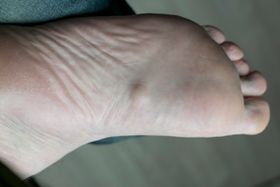How to Fix Overpronated Ankles
Updated December 17, 2024

Ankle overpronation, often known as flat feet, is a natural occurrence that occurs when the arches of the foot roll inward or downward while walking. The foot strikes the outside of the heel, then rolls inward (pronates), shifting weight to the inner edge of the foot rather than the ball of the foot. Overpronation can also occur while standing, and pronation refers to the degree that the foot rolls inward toward the arch.
As such, it is easy to check for overpronation by dipping your feet in water and standing normally on a sheet of cardboard or paper. If your connecting arch fills more than half of the width of the impression, there's a good chance you have overpronation.
People who overpronate are more likely to sustain particular injuries and knee, hip, and back pain. This is because it creates more impact when the foot strikes the ground by disrupting the body's normal position. Overpronators, athletes especially, are more prone to overuse injuries.
Causes and Risk Factors of Overpronation
Flat feet and overpronation are often related and influenced by each other. Overpronation occurs when the muscles, ligaments, and plantar fascia (arch) of the foot are strained, overused, or worn down, causing the foot to flatten too much and roll inward as it contacts the ground. Sometimes people with flat feet are born with them. However, certain factors and circumstances might raise a person's risk of developing flat feet or weakened arches, which can contribute to overpronation.
The following are some examples of causal conditions and situations:
- Pregnancy
- Being overweight or obese
- Participating in any activity that requires striking the foot repeatedly on a hard surface for an extended period of time, such as running
- Wearing incorrect footwear
Can Overpronation Be Cured?
Yes, foot and ankle overpronation is curable. A doctor might suggest a variety of treatments to reduce pain and avoid re-injury. Treatment options for overpronation include the following:
- Selecting footwear the supports the arches
- Wearing orthotics or insoles for overpronation
- Wearing custom insoles for flat feet
- Exercising to strengthen the arches and the muscles that surround them
People who have been injured by overpronation can take efforts to prevent further damage. The fusion can take up to 12 weeks to properly heal, and no weight should be placed on the foot for at least half of that time. Because of the lengthy immobilization, physical treatment may also be required.
Footwear for Treating and Preventing Overpronation
Things to look for while choosing orthotics or footwear for overpronated feet include:
- Overpronation stability shoes These use a strong midsole motion control system known as a medial post, and sometimes ankle braces, to stabilize the foot and help with overpronation.
- Adequate cushioning Overpronation necessitates the use of specialized cushioning technology. Look for a foam that is both soft and springy while yet being stable.
- Limited flexibility Shoes with excessive flexibility will exacerbate your foot's natural tendency to roll inward. It's critical that your footwear keeps your feet secure.
- Reinforced heel counters These are a frequent component of stability shoes that provide maximal support for overpronated feet during a long run.
Wear your orthotics for overpronation only two to three times during the day, a few minutes at a time, for the first few days. Remove your orthotics in between wears to give your body a rest, and increase the time you wear them daily.
Exercises for Treating and Preventing Overpronation
A physical therapist is referred to a person with overpronation for strengthening exercises to correct pronation. These exercises for collapsed arches should help strengthen the muscles, help to lower loading forces, and reduce the pain of flat feet:
Calf Raises
- Your feet should be together when you stand.
- Engage your calves by rising onto the balls of your feet.
- Lower down until you feel a stretch in your calves
- keep your knees straight but not locked.
Glute Bridge
- Lie down on your back.
- Wrap a resistance band around your legs, slightly above your knees.
- Raise your hips and push your knees out further.
- Maintain outward tension on the band as you return to the starting position.
Jump Lunge
- Begin with your right thigh parallel to the floor in a lunge position.
- Jump high and switch legs in mid-air, bringing the left leg forward.
- Land as softly as possible.
A-Skip
- Start skipping with your feet together, forcing your right knee up hard to raise you off the ground.
- Drive your foot back down toward the ground while keeping it flexed
- Repeat on the other side.
Other Ways to Treat Overpronation
Excessive pronation can be treated conservatively by realigning the foot using a stiff orthotic to realign the subtalar joint. This type of orthotic is typically worn indefinitely.
Another option is surgical reconstruction, though this is difficult and time-consuming. If surgery is required, it may take up to a year to return to your previous state.
When Should You See a Doctor for Overpronation?
A diagnosis can be made by a podiatrist, orthopedic surgeon, or physical therapist. If you are enduring pain or a persistent injury as a result of overpronation, you should visit a specialist, especially after self-correction treatments have failed you.








